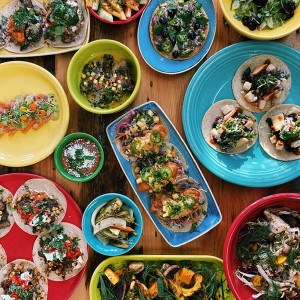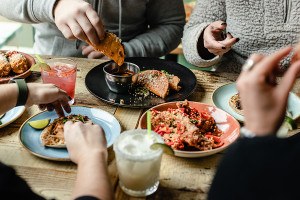The Long and Troubled History of Beer in New England

Author Lauren Clark looks at the history of beer in New England in her new book, “Crafty Bastards.” Photo provided.
That story you heard was true. The Pilgrims never intended to land in Plymouth Harbor. Their real intention was to head further south to the Hudson River, but they were running low on beer. That anecdote sets the tone for Lauren Clark’s new book Crafty Bastards, which details New England’s long and oftentimes troubled relationship with beer. Clark, a journalist and former brewer who founded the immensely popular site DrinkBoston.com, chronicles four centuries worth of beer-centric history in the Northeast, from the tavern’s integral role in the American Revolution to the importance of figures like Jim Koch (Samuel Adams), Rob Tod (Allagash), and even Todd and Jason Alström (BeerAdvocate.com) in the rise of craft beer. I sat down with Clark to discuss some of the finer points of her book, including the Puritans strained relationship with alcohol, women brewers, boozing children, and the current crop of “rockstar” craftsmen.
How important was beer to early New Englanders?
To put it simply, it was a dietary staple. It was food and beverage. It was part of the culture to the early colonists. In England, beer was safer to drink than water. In the first chapter of my book I joke that everyone knew water was poisonous. They didn’t have modern sanitation practices or modern sewage systems. In beermaking, the germs are boiled right out of the water. It also has alcohol, which acts as a preservative. Essentially, beer was a way to hydrate without catching dysentery.
Can you describe the uncomfortable relationship the Puritans had with beer consumption?
There was a complicated relationship because it was a dietary staple, but it was also something that caused drunkenness, which they considered a sin. They tried really hard to get the populace to drink in moderation. They actually considered beer to be the drink of moderation, but at the same time there were people going to taverns and getting drunk. They would enact laws that would dictate the quality of beer the tavern keepers had to provide and force them to serve beer provided by licensed brewers. The problem was that there would typically only be one licensed brewer. Supply didn’t meet demand and so people would drink hard liquor instead. They were just typically Puritan and tried to social engineer people’s drinking habits, which inevitably backfired.
Could you describe the role of women in early New England brewing?
Most of the beer before the Industrial Age was brewed by women in the home and also in the tavern. Early taverns were just in people’s houses. They were normally run by an honorable man in the community, but presumably his family was helping him, and the wife was the one doing all the brewing. If he died, the wife would take over as proprietor and brewer. The woman brewer, or Brewster (which is a really archaic term), was a tradition that had been the case for centuries before in Great Britain. Up until the mid-1800s in the U.S. it was still that way. In Lydia Marie Child’s book, American Frugal Housewife, she called beer “a good family drink.”
Weren’t children consuming beer at the time?
Yes, if you gave polluted water to your children, they would die or at least get very sick. The water in the new world was fine because there was no pollution yet, but the colonists inherently did not trust water because of it’s reputation in Europe. But what they were serving kids was table beer that was three-percent alcohol or less. When people first came to the New World there was nothing else to drink. They didn’t have coffee or tea at that point. That was still a few decades away.
You spent some time as a professional brewer in Boston. How long did you do that?
I was Will Meyer’s brewing assistant at Cambridge Brewing Company for two years. I hadn’t ever had that physical a job before or since. I had never been in manufacturing, which is pretty much what brewing is. It’s physical and very visceral. It’s all about smells and sounds. Brewing is all about fine tuning your senses. I worked there from 1997 through 1999 at the tail end of the first big craft beer boom.
In the book, you talk a lot about the craft beer crash of the late-‘90s. What factors do you think played into that?
There were a lot of people entering that market and a lot of them weren’t producing very good beer. There was also a war taking place between the mega breweries and the craft breweries, where the large corporate breweries were sewing seeds of uncertainty about craft beer. They really went after Jim Koch and Boston Beer Company, saying “he’s falsely presenting himself as this little craft brewer from Boston when he’s actually quite big and producing in Pennsylvania and Cincinatti.”
So how did the craft beer industry recover from that?
In New England, very slowly. Most breweries in New England did survive, but they had this period of doldrums where they weren’t sexy or in the news anymore. There were also beers coming in from Colorado, California, and the Pacific Northwest that were more popular. Eventually all the New England brewers woke up and said “hey, look at what these West Coast breweries are doing, maybe we should start making some interesting beers.” Around 2007, it was like New England craft beer scene reawakened, particularly with people like Dann and Martha Paquette starting Pretty Things.
Do you think that this wave of popularity for craft beer will be as fleeting as it was in the ’90s?
I actually wouldn’t be surprised if there were another crash, but my longterm outlook is way more optimistic. We have a much bigger population of people now who understand craft beer and we have a whole new generation of people who grew up with it. It’s not a weird thing to them. And brewers now are making better beer because you have to. There’s more competition. Plus, there’s more experience out there. In the ’90s brewers couldn’t just Google recipes and techniques.
In your estimation, who is the most important figure to have emerged in the New England beer scene?
The most obvious answer would be Jim Koch. but even though he’s based in New England, I really consider him an American brewer. He’s hugely important to American craft beer and he’s certainly one of the top figures of all time. But two of the really unknown people that should be recognized are Pat Baker and Nancy Crosby who started selling homebrew supplies in the early ’70s in Westport, Connecticut. They were one of the biggest supply houses in the country. They sold supplies and offered training to a number of people who eventually became craft brewers. Nancy was instrumental in getting the law changed that made homebrewing legal again. She went to Washington and lobbied congress on behalf of homebrewing. The supplies they were selling weren’t illegal at the time, but what their customers were doing with them certainly was.
What are some of your favorite New England beers right now?
I like to try different things all the time, but I really like Pretty Things and Notch’s beers. I think the session beer trend is really refreshing. I also really like Jack’s Abby’s flagship lager, Jabby Brau. Then of course, there’s the rockstar Vermont brewers like John Kimmich at Alchemist Brewery with Heady Topper and Shaun Hill’s beers at Hill Farmstead, which I think warrant all the attention they get.


